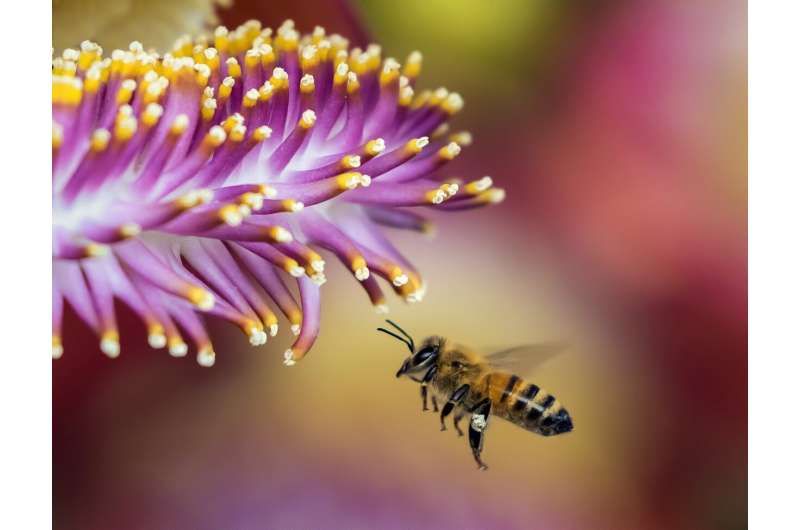Credit: Pixabay/CC0 Public Domain
The honey bees looked perfectly healthy as they buzzed around their boxy wooden hive on a warm fall day in central Pennsylvania.
Elizabeth Capaldi suspected otherwise.
The biologist, dressed in a white hazmat suit and hat, reached out with a gloved hand to capture one of the insects in a small vial, then brought it back to her Bucknell University lab to dissect its brain.
Her colleague David Rovnyak later placed a sample of the bee’s innards in a large metal cylinder and blasted it with high-frequency radio waves — a type of scanning technology that revealed the levels of certain telltale chemicals inside.
Their goal: to identify early warning signs that a bee is under stress, so beekeepers can try to save a threatened hive before it’s too late.
Honey bees have been in decline for decades, causing headaches and higher costs for farmers who depend on the insects to pollinate their apples, almonds and 130 other fruit, nut and vegetable crops. The problem made headlines in 2006 with the emergence of a mysterious new phenomenon called Colony Collapse Disorder, but the general decline in bee health was underway long before that and continues to this day.
Causes include climate change, pesticides and disease, said Capaldi, who studies insect behavior and neuroscience at the Liberal Arts University in Lewisburg. In bad years, the combination of insults can wipe out more than half of a beekeeper’s colonies.
“Honey bees are suffering,” she said. “All of these factors have combined to create a stressful environment for honey bee colonies across the country.”
She and Rovnyak, a chemistry professor at Bucknell, realized five or six years ago that the problem might lend itself to an interdisciplinary solution. The pair joined forces with colleague Marie Pizzorno, an expert on viruses, as a virus deforming their wings is a factor in insect demise.
They want to identify chemical stress indicators that rise in a bee’s brain months before the insect shows outward signs of decline.
The cylindrical device Rovnyak uses to detect these substances, called a spectrometer, would be impractical for any beekeeper or farmer. But once researchers have determined which chemicals are the best predictors of bee health, they want to develop an inexpensive test that could be used in the real world.
Double the cost
Every spring, when the apple blossoms begin to bloom, a flatbed truck loaded with 100 honey bee hives rolls into Hollabaugh Bros. Farm in the dead of night.
Workers set up the boxy containers on 150 acres that produce more than 50 varieties of apples, said Ellie Hollabaugh Vranich, assistant manager of the farm in Biglerville, north of Gettysburg.
“We’re trying to spread them while it’s still dark before the bees wake up,” she said.
A decade ago, the farm rented the hives for $50 apiece. A few years ago the price went to $60, and last spring it was $100, for a total of $10,000, she said.
Beekeepers have cited a number of reasons for the increases, including higher fuel costs and disruptions related to the COVID-19 pandemic. But each year, a major factor in higher costs is that many colonies do not survive the winter, meaning beekeepers must struggle to raise new ones in time for the growing season.
“You can’t just make a bee on a processing line in a factory,” Vranich said. “They need to be bred and given time to develop new hives.”
Experienced beekeepers like Capaldi, the Bucknell scientist, can often tell when a hive is beginning to fail simply by looking at it. Perhaps the insects have not accumulated long-term stores of honey, instead feeding on liquid nectar. Brood shortage is another warning sign.
But by that point, it might already be too late.
A year ago, Capaldi found that her eight hives at Bucknell were under stress, likely because the Japanese asters and goldenrod had been producing less nectar than usual. So she supplemented the insects’ diet with sugar throughout the winter.
Despite this, only two of the hives survived.
find culprits
The first signs of trouble for the insects came in the 1980s with the introduction of a parasitic mite from overseas, said Pizzorno, Bucknell’s virologist.
In relation to the size of the honey bee, these parasites, called Varroa destructor, are enormous.
“It would be like having a tick the size of a plate on your body,” she said.
Scientists later discovered that the parasites not only harmed them directly, but also transmitted a virus to the honey bees that deformed their wings.
Researchers have also found that climate change is affecting bees in a variety of ways, Capaldi said. Early warm spells or unusual rain patterns can cause flowers to bloom too early and disappear as the insects search for nectar.
“As the colony grows, the flowers may not be available,” she said.
Certain pesticides and other large-scale industrial farming practices can also increase stress, she said. This includes the way the bees are deployed, transported from farm to farm where they feed on a crop for days.
In the 1990s, beekeepers increasingly reported that some of their colonies were not surviving the winter. Then, in 2006, beekeepers discovered that some colonies were dying in unusual ways. Instead of dying in or near the hive, the bees simply disappeared and apparently flew away to die elsewhere.
While beekeepers have reported fewer cases of this colony collapse disorder in recent years – partly because they have developed better management techniques – the causes remain somewhat unclear. Capaldi blames many of the same factors responsible for the general decline in bees that began in the late 1980s.
Telltale chemicals
The sturdy silver spectrometer at Bucknell contains a magnet that’s stronger than those used in MRI machines, said Rovnyak, the chemistry professor. To identify telltale metabolic chemicals in a bee’s brain, he places the tiny blob of material in a small container at the center of the device and then hits it with radio waves, causing the different substances to resonate so their relative amounts can be measured.
“Each molecule rings with a specific set of patterns, like a chord,” he said.
In one study, he and the others found that an amino acid called proline was elevated in the brains of honey bees infected with deformed wing virus — long before they showed outward signs of disease.
The scientists have since identified other protein fragments that could be signs of stress – possibly because the insects are changing their eating habits in response to the infection – but more work is needed.
Once the Bucknell researchers narrow down the best chemical predictors of a bee’s demise, they hope to develop an inexpensive, rapid test that beekeepers can use.
“If we could come up with something for a few bucks, that might be appealing,” Rovnyak said.
He compared the approach to certain blood tests for people who, for example, can detect metabolic signs of type 2 diabetes years before the onset of the disease. Much like people with prediabetes can ward off disease by changing their diet, beekeepers could do the same for the insects. Like feeding them sugar, but starting Bucknell’s colonies earlier than Capaldi did last year. Or the use of other tactics that have shown promise in limiting colony collapse, such as B. treating mites, moving hives or introducing another queen bee.
Meanwhile, significant portions of colonies fail each winter — 30% one year, 40% or 50% the next, according to surveys by the nonprofit Bee Informed Partnership. For now, breeders have kept up with the demand for new colonies. But at some point, they might not do it anymore, Rovnyak said.
“It just seems to get more and more challenging every few years,” he said. “And there’s no sign of that stopping.”
2022 The Philadelphia Investigator.
Distributed by Tribune Content Agency, LLC.
Citation: Honeybees in Danger, Along with the Crops They Pollinate: Scientists Think the Solution Lies in Insects’ Brains (2022, December 29) retrieved December 29, 2022 from https://phys.org/news/ 2022-12-honeybees-crops-pollinate-scientists-solution.html
This document is protected by copyright. Except for fair trade for the purpose of private study or research, no part may be reproduced without written permission. The content is for informational purposes only.









